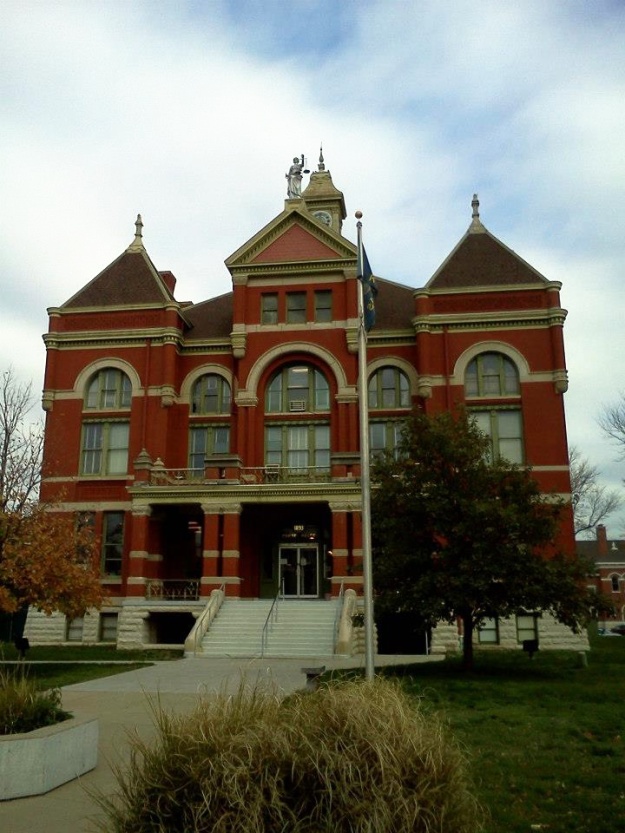Kansas courthouses play an important role in Shadow on the Hill: The True Story of a 1925 Kansas Murder. Unfortunately, only one of the three courthouses mentioned in the book is still standing.
Franklin County Courthouse, Ottawa, Kansas
John Knoblock and Florence Mozingo traveled to Ottawa, Kansas to be married at the Franklin County Courthouse on November 8, 1916. The Franklin County Courthouse was designed by prominent Kansas architect George P. Washburn (no relation to the Washburn of Washburn University), who made his home in Ottawa, Kansas. The courthouse was constructed in 1893 and continues to serve as the county’s courthouse. It was placed on the National Historic Register in 1972. You can see a picture of the courtroom here. The Knoblock’s marriage license is included in the Vital Statistics section of the Shadow on the Hill Documents page.

Still standing, the Franklin County Courthouse was built in 1893 and designed by prominent Ottawa, Kansas architect George P. Washburn.
Coffey County Courthouse, Burlington, Kansas
The courthouse that witnessed John Knoblock’s first murder trial was actually Coffey County’s second courthouse. A “Free Classic Romanesque” building designed by another prominent Kansas architect, J. C. Holland, was completed in 1901 at a cost of $38,000. According to Wanda Christy’s Coffey County: Vol. 1: A glimpse into its past, present, and future!, the contractor hired to build the courthouse complained that the plans didn’t call for enough concrete, and by 1911, the walls were already cracking under the windows and over the doors. “It was stated that this was the best constructed building in Kansas, but was constructed on a weak foundation,” Christy wrote.
By the time a new courthouse (courthouse #3) was under construction in 1963, the walls of the 1901 building were being propped up by long poles. The courthouse has been torn down. You can see some of the documents connected to the trial in the Trial Documents section of the Shadow on the Hill Documents page.

Coffey County’s second courthouse was completed in 1901. John Knoblock’s first trial was held here. Photo from the Kansas Collection at the Spencer Research Library at the University of Kansas.
Lyon County Courthouse, Emporia, Kansas
John Knoblock’s second trial was held at the Lyon County Courthouse in Emporia. According to Laura M. French’s History of Emporia and Lyon County, this was the second courthouse. The first courthouse was built in 1866 at Third and Commercial, where the Poehler Merchantile building, which was constructed in the courthouse’s place after it was torn down, still stands today.

The second Lyon County Courthouse was completed in 1903. John Knoblock’s second trial was held here. Photo from the Kansas Collection at the Spencer Research Library at the University of Kansas.
A contemporary of the Coffey County building, the cornerstone was laid in 1901 and the building was completed 1903 for $55,000, a price that included the cost of the furniture and interior fixtures. The new courthouse, which was designed by another important Kansas architect, Charles Squires, was located on the northeast corner of Fourth and Commercial. Because it was only slightly farther from the railroad tracks than the previous courthouse, court was regularly disturbed by the sound of trains and traffic coming through town. The building remained in use until a far less aesthetically appealing third courthouse was build in its place during the 1950s. The fourth–and much more stately–courthouse was completed in 2001 and uses the third courthouse as an annex building. All that remains of the beautiful second courthouse is the stone archway that once graced the entrance.


Incredible that somebody saved that arch! Wouldn’t you love to have that frame your driveway?
I know, right? It’s so grand. The amazing thing is that it ended up in the driveway of a property called The Rocks, which mysteriously exploded in 1962, killing a couple of people inside. It was ruled an accident, but not everyone was convinced.
Very cool info!
Thanks!
How I wish we still had the grand courthouse! She was such a beauty, unlike the modern buildings.
The newest Lyon County Courthouse at least has some style. The construction of the 1950s government buildings should be considered criminal offenses.
Pingback: Sunday Snapshot: Anderson County Courthouse | Diana Staresinic-Deane